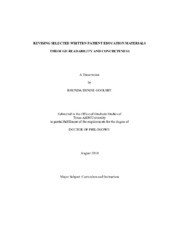| dc.description.abstract | The current state of much research on written patient education materials (WPEM)
suggests that they are written in a manner that is too difficult even for educated patients
to understand and remember. Much of the research in this area is focused on
modification of the readability of WPEM, which has shown to be relatively ineffective.
In this study, an attempt was made to determine if a theory-based method in revising
WPEM for improved comprehensibility and memorability was effective.
The effectiveness of three versions of WPEM regarding breast self-exams (BSEs)
was examined; the original version without illustrations obtained from the American
Cancer Society website, a version that was written at a lower readability level as
measured by the Flesch-Kincaid readability formula, and a version with a lower
readability level as measured by the Flesch-Kincaid readability formula and the
increased use of concrete language as suggested by Dual Coding Theory. The researcher
compared the percentage of recall of idea units recalled by 76 participants at two time
periods: immediately after reading the randomly assigned version of WPEM and seven
days after the initial reading.
The WPEM that contained the lower readability level and concrete language was
most recalled by participants both at immediate recall and delayed recall. In fact, the
delayed recall of the WPEM that contained the lower readability level and concrete
language after the seven-day period was almost equivalent to the immediate recall of the
participants in the other two groups. A significant main effect was found for the forms of
WPEM, F(2, 73) = 27.69, p = .00, n2
p = .43 with an observed power of 1.00. A
significant main effect was found for time, F(1, 73) = 161.94, p <.00, n2
p = .69 with an
observed power of 1.00. A significant interaction of WPEM and time was found, F(2,
73) = 5.07, p = .01, n2
p = .12 with an observed power of .80.
Reported levels of frequency of performing BSEs and levels of confidence in
performing BSEs were also analyzed using the Wilcoxon Signed Ranks Test in relation
to the three WPEM versions over time. Reported frequency was significantly greater
after seven days, regardless of form of WPEM (WPEM A, p = .32; WPEM B, p = 1.00;
WPEM C, p = .74). Levels of confidence were significantly greater after seven days,
regardless of form of WPEM (WPEM A, p = ..02; WPEM B, p = .00; WPEM C, p =
.00).
Overall results indicate that combining reduced readability and increased
concrete language is beneficial. The writing of WPEMs in a way that patients can
understand should be supported by a theory, and infusing Dual Coding Theory in the
writing of selected WPEMs may be beneficial for patients. | en |


